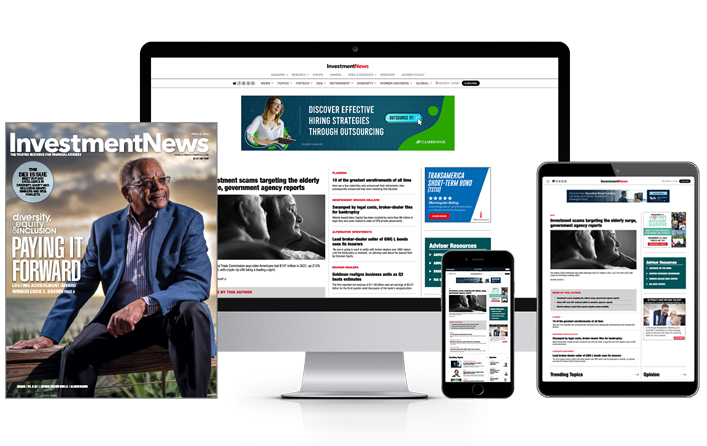New fee disclosure rules could shake up 401(k) world
Financial advisers who work with 401(k) plan sponsors — as well as those prospecting for new clients in the retirement plan arena — will get a chance to shine this summer when new Labor Department fee disclosure rules kick in July 1.
Plan sponsors likely will be inundated with paperwork from record keepers, trustees, custodians and other service providers who now must break out the details of the fees charge and the services they provide. (Don’t forget to send your own disclosure documents to your plan clients by the July 1 deadline).
There is no uniform format for the disclosures, which could run 20 pages or more, and the regulations don’t require a summary document.
“There is a significant opportunity for advisers to come in and interpret all this information for their plan sponsor clients, including calculating all-in costs,” said Greg Tschider, chief executive of Verisight Inc., which provides retirement plan services and consulting solutions to employers, advisers, financial intermediaries and human resources administrators. “It’s a great time to be prospecting, too.”
The fee disclosures could come as a shock to some plan sponsors.
A recent survey by the Government Accountability Office found that some sponsors didn’t know whether their providers used complex fee arrangements, such as revenue sharing. Other sponsors said that they knew about the arrangements but didn’t fully understand how fees were charged.
After July 1, sponsors for the first time will be able to make apples-to-apples comparisons of the cost of services among various providers.
“It could be a real game-changer,” said Jason Frain, vice president for 401(k) product management and development for The Guardian Life Insurance Co.
“Financial professionals need to be in a position to effectively explain fees and distinctly identify how they, as service providers, add value,” he said. “It puts them in an excellent position to educate their clients on the new rules and assist them as they make service provider selections.”
To help advisers get up to speed, Guardian is offering a new report about navigating the landscape of fiduciary and fee disclosure regulations on its retirement website. The material explains the rules for operating as a fiduciary — providing investment advice and, in some cases, investment management — as well as being a nonfiduciary in providing education.
Many broker-dealers are still examining whether they will allow their registered representatives to act in a fiduciary capacity.
For advisers acting as fiduciaries, compensation must be in the form of a fixed fee, which could be a flat dollar amount, a percentage of total assets or a per-participant amount. If a fiduciary suggests a distribution from a plan, he or she is prohibited from cross-selling products and services such as Section 529 college savings plans and insurance.
For advisers who choose not to be fiduciaries, now is the time to document all the ways they assist plan sponsors in providing information, education and other services to their plan participants, and to itemize — and justify — their fees.
SMALL-PLAN MARKET
For advisers looking to expand their business, the retirement market opportunity is significant, particularly in the fast-growing small-plan market, where sponsors are most likely to need help. But small plans present economic challenges, too.
Their low assets and limited number of participants may be insufficient to support a flat or fixed-fee billing arrangement required of a fiduciary. One solution is to suggest that plan sponsors use the fiduciary support services of a third-party registered investment adviser.
Once plan sponsors tally their total costs, some may seek cost-cutting alternatives, said Greg Carpenter, founder and chief executive of Employee Fiduciary, a 401(k) administrator that focuses on small plans.
He suggests that advisers keep it simple by breaking down costs into three buckets: investment fees, advisory fees and everything else that they need to run a plan.
“If the everything-else bucket seems too large, start to unpack it,” Mr. Carpenter said.
The next time bomb will be when plan participants receive their initial fee disclosure statements, due by Aug. 30.
Although the majority of participants probably do not understand or care about the fees that they are paying for their 401(k) plan, a small, vocal minority does.
And in the new era of social media, their complaints and questions could go viral. Don’t dismiss them.
“These power participants are likely to be more engaged, have larger account balances and be higher up in the organization,” Mr. Carpenter said. “They could be influential in picking the plan’s investment adviser.”
Mary Beth Franklin (mbfranklin @investmentnews.com) welcomes your comments and suggestions for column -topics.
Learn more about reprints and licensing for this article.





